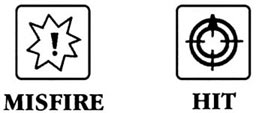Welcome to Warhammer, the game of fantasy battles. Warhammer is a game of combat in which players take command of painted miniature armies complete with infantry regiments, cavalry squadrons and lumbering war machines. This book contains all the information you will need in order to play Warhammer, as well as background information, advice on collecting and painting an army, running a campaign, and much more besides. In Warhammer, the opposing factions – the armies – are represented by models, assembled and painted by you. Your tabletop becomes part of the Warhammer world, be it the steaming jungles of Lustria, the wind-swept plains of Kislev or the forbidding forests of the Empire. The aim of the game is to outfight your opponent, which requires a mixture of both skill and luck. You’ll soon learn how to arm and design your army effectively and how to exploit the terrain to your best advantage. You’ll probably want to expand your basic force as you play more games. This is easy as there are lots of models available for the armies and new miniatures will be coming out all the time. With these you can expand your army, equip your heroes with different weapons and armour and hire mercenaries to join your force. If you’re new to the Games Workshop games you’ll be reassured to know that finding other players is not normally a problem – you’ll be surprised how many there are! There may be a Games Workshop store near you where you can buy models, paint and games supplements. However, Games Workshop stores are not just shops, they are hobby centres, where the staff will happily help you learn the rules, show you how to paint and suggest ways to develop your army. As well as this book, you will need the following items to play Warhammer: You will need enough miniatures of the appropriate race/type to represent the warriors in your army. It is a good idea to work out your army on paper first and then purchase the miniatures that you require. As you will see in the section called Warhammer Armies, each army fights in a particular way – some contain expert archers while others are better in close combat or have mighty magicians. When choosing which army to lead you could choose one that reflects your preferred playing style, or you could read The Warhammer World section and choose one that really captures your imagination. A good way of picking an army is simply to pick the one with the models you like the best. You will also need something to play your battles on. Any firm, level surface is best, such as a tabletop or an area of floor – most kitchen tables will do. It’s a good idea to use an old sheet or blanket to protect the table from scratches. Some players make a special gaming board from chipboard or other similar material (divided into two or more pieces for ease of storage) which they can use on top of a table to extend the playing area. Whatever you use, you will find that an area approximately 6’ x 4’ is about right for most battles. Breath weapons of certain creatures like Dragons, as well as the shots of certain war machines, use templates to represent the area affected. There are three templates you need: a teardrop shaped flame template and two round templates with 3” and 5” diameter respectively. At the back of the book we have included templates which you can photocopy and use in your games. For measuring ranges you will need a tape measure marked in inches, or a couple of plastic range rulers. You will also need pens and paper to record your regiments’ weapons and other details. All dice rolls use a standard six-sided dice (usually shortened to D6). Sometimes you will be asked to modify the result of the dice roll. This is noted as D6 plus or minus a number, such as D6+1 or D6-2. Roll the dice and add or subtract the number indicated to get the final result. You may have to roll a certain number of dice and add the scores together. You may also come across the term D3. As there is no such thing as a three-sided dice, use the following method for determining a score between 1 and 3. Roll a D6 and halve the score, rounding up: 1 or 2 equals 1; 3 or 4 equals 2; and 5 or 6 equals 3. 
Special dice symbols are used to represent occurrences of luck and misfortune. From this point onwards these are referred to as MISFIRE and HIT. The corresponding symbols are shown below: Warhammer uses two special dice: the Artillery dice marked 2,4,6,8,10 and MISFIRE, and the Scatter dice marked with arrows and HIT symbols. These dice are used to represent the effects of various war machines such as cannons and stone throwers. Sometimes the rules allow you a ‘re-roll’ of the dice. This is exactly as it sounds – pick up the dice you wish to re-roll and roll them again. The second score counts with a re-roll even if it is a worse result than the first, and no single dice roll can be re-rolled more than once, regardless of the source of the re-roll. |